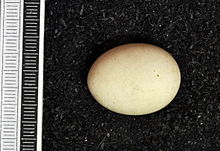Storm wave runner
| Storm wave runner | ||||||||||||
|---|---|---|---|---|---|---|---|---|---|---|---|---|

Storm wave runner ( Hydrobates pelagicus ) |
||||||||||||
| Systematics | ||||||||||||
|
||||||||||||
| Scientific name | ||||||||||||
| Hydrobates pelagicus | ||||||||||||
| ( Linnaeus , 1758) |
The storm wave runner ( Hydrobates pelagicus ) is a small black seabird with a characteristic white rump . It is primarily found in the North Atlantic . It wasn't until 2019 that the name was changed from petrel to storm wave runner.
The birds belonging to the order of the tube noses (Procellariiformes) are sea birds that live almost their entire life in the open sea and only come on land to breed. The storm wave walkers have a very well developed sense of smell, which they use when looking for food and when they go to their nesting site on land at night. On land they can only be seen flying in the colonies during the breeding season.
In Central Europe she is an almost regular errant on the North Sea coast of Belgium, the Netherlands and Schleswig-Holstein. It is less common on the Baltic coast and only rarely seen inland. For example, after a storm in 1999, a troop of forty individuals could be seen in Switzerland.
Appearance
With its weight of 27 g, its length of 16 cm and its wingspan of 37 cm, the storm wave runner is one of the smallest seabirds ever.
The first syllable in the former German name Sturmschwalbe, Sturm , can be found in many other languages. The reason for this is that storm wave walkers were often seen after a storm. It got the name swallow because of its narrow and pointed wings, which make the petrel resemble a swallow at first glance . However, with its special beak and webbed feet , it is unmistakable.
Because of its white backside, the storm wave runner is called Drunnhvíti in the Faroe Islands . A drunnur is a rump and hvítur denotes the color white.
distribution
The world's largest colony of storm wave walkers is believed to be on Nólsoy . The petrel also breeds in other places in the Faroe Islands , but nowhere in the same numbers as on Nólsoy. The storm wave runner is mainly found in the area between Iceland , Lofoten and Scotland . Around 30,000 storm wave walkers were ringed in the Faroe Islands. This suggests that they hibernate in South Africa .
Way of life and reproduction
The food of the storm wave runner consists u. a. made of plankton (krill), small fish and squid , which it ingests when it “walks over” the surface of the water.
The first storm wave runners from South Africa reach the Faroe Islands at the end of May. Their nesting places are often under stones. Between July and August they lay a large, white egg weighing about 7 grams, which they hatch for about 40 days. The cub is fed every night for approximately 50 days until it is overfed. After that it is abandoned by the adult birds. In 8 to 12 days, it has lost enough weight that it can take off and begin its long journey to South Africa. The young return to the breeding area when they are 2 years old and reproduce for the first time at 3 to 4 years of age.
Natural enemies
The worst enemy of the storm wave walkers are species from the genus of rats (Rattus). The herring gull ( Larus argentatus ) and the arctic skua ( Stercorarius parasiticus ) also eat some of the adult birds. But the storm wave walkers try to protect themselves against these enemies by only flying ashore when it is dark. In some places, tame cats are also a great danger to the storm wave walkers.
When the storm wave walker is disturbed, it defends itself by spitting oil from its stomach. The storm wave runner has a very characteristic odor that is attached to most seabirds.
The storm wave runner in popular human belief
Historical sailors referred to the storm wave runner as a bad luck bird that causes storms. Myths existed in many locales that stormwave runners were viewed as the souls of drowned sailors to be fair with.
The smell of the birds, reminiscent of fish liver, led to the fact that they were given the name Lever-Lars (Leber-Lars) in Norway .
Name change in German
Until 2019 the species carried the German name Sturmschwalbe. In October 2019, the species was renamed Storm Wave Walker, as the species is one of the wave walkers according to genetic studies.
Web links
- Hydrobates pelagicus in the endangered Red List species the IUCN 2008. Posted by: BirdLife International, 2008. Accessed January 31 of 2009.
- Page no longer available , search in web archives: Stamps.fo - Sturmschwalben (Public Domain and basis of this article)
- Videos, photos and sound recordings of Hydrobates pelagicus in the Internet Bird Collection
Individual evidence
- ↑ Hans-Günther Bauer, Einhard Bezzel and Wolfgang Fiedler (eds.): The compendium of birds in Central Europe: Everything about biology, endangerment and protection. Volume 1: Nonpasseriformes - non-sparrow birds , Aula-Verlag Wiebelsheim, Wiesbaden 2005, ISBN 3-89104-647-2 , p. 205
- ↑ Sven Nilsson , Foglarna, 1858
- ↑ Peter H. Barthel, Thorsten Krüger: List of birds in Germany: Version 3.2 German Ornithological Society, Radolfzell 2019.
